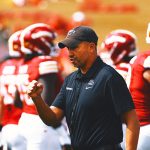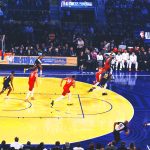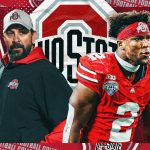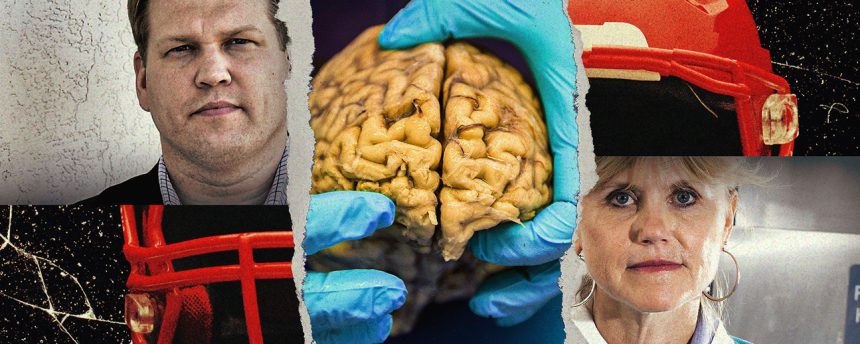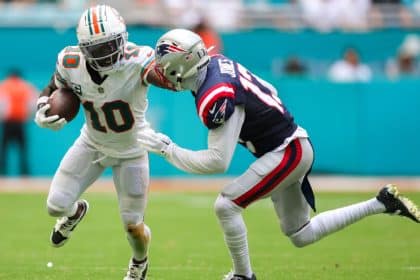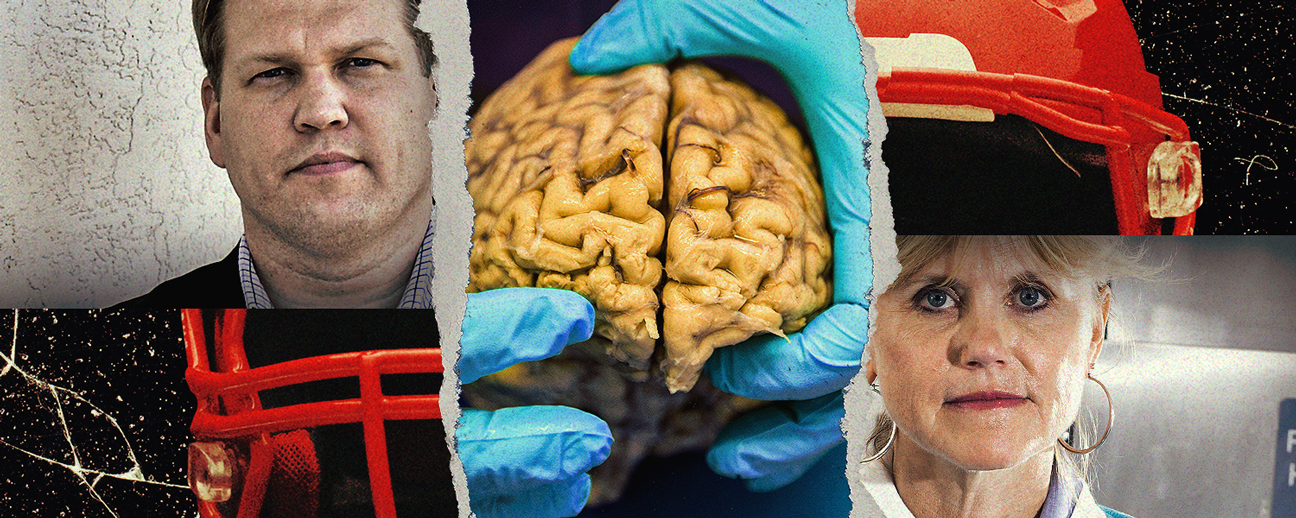
A YEAR AGO, as more than 6,000 media representatives descended on Arizona for Super Bowl LVII, Boston University’s Chronic Traumatic Encephalopathy Center issued a news release with the headline: “Researchers find CTE in 345 of 376 former NFL players studied.” It emphasized that two of the brains dissected in the previous year and found to have the neurodegenerative disease tied to football came from men who once played for the very teams that would be vying for the Lombardi Trophy, the Philadelphia Eagles and the Kansas City Chiefs.
The release had no new information about CTE itself, nor was it tied to fresh research produced by BU. Still, it had the desired effect: It put the topic back on the radar on the eve of football’s biggest event. The idea to issue the release had come from Chris Nowinski, a BU researcher and the co-founder of the CTE Center’s education and advocacy partner, the Concussion Legacy Foundation.
Sometimes “people need to be exposed to certain ideas and information multiple times to understand, you know, to learn them,” Nowinski told ESPN recently.
What we’ve learned about CTE and its connections to football has been shaped largely by the research produced by BU over the past 15 years. That work has led to a revolution in the way America considers its most popular sport: instilling a deeper understanding that repetitive hits to the head can lead to cognitive problems later in life, prompting reforms at all levels of the sport, sparking a decline in participation and spawning legislative debates in some states, most recently California, about whether youth tackle football should be banned altogether.
But the narrative about CTE has outpaced the science. Fueled by the publicizing of several high-profile cases and data that even the BU researchers acknowledge is limited, the result is a heightened level of fear in players and families, from the pros down to pee wee. That fear has led some NFL players, teenagers and weekend warriors to conclude — fatalistically — that whatever cognitive or emotional troubles they’re enduring must be rooted in CTE; and it has created tensions within the research community that the story has become far too simplified.
Somewhere in the middle of this sits BU, the undisputed king of CTE research.
“I’m very respectful of what [BU has] done,” said Dr. Aaron Baggish, a former cardiologist for the New England Patriots and a member of a Harvard University research team studying former NFL players. “But it has contributed to a very single-sided discussion and has, unfortunately, left many to think that this is a much simpler problem than it really is.”
BU has “taken over the research, [it’s] all you hear from,” said a leading expert on brain injury and neurocognitive disease who spoke on the condition of anonymity. “I really wish these cases wouldn’t be publicized so heavily.”
EVEN AS THE BU group dominates CTE research, one pervasive truth remains, which the researchers readily admit: Their work suffers from a “tremendous selection bias.” It’s built on a select sample of football players who reached the very highest level of the sport; a specific set of NFL players who, years after they retired, were so cognitively addled that their families donated their brains for study.
Yet, the numbers screamed out in headlines, from The New York Times to ESPN: “New Study of 111 Deceased NFL Players Finds 99 Percent Had CTE” … “111 N.F.L. Brains. All But One Had C.T.E.” … “How CTE was found in 110 of 111 Ex-NFL players’ brains.”
Plus, there were high-profile cases of former NFL stars losing themselves and then killing themselves or others. Stars like Junior Seau or Aaron Hernandez. Or Dave Duerson, who went from CTE nonbeliever to shooting himself in the chest and leaving a note directing his brain to be studied.
Suddenly, the very thought of a forgotten name, a misplaced set of keys, or a missed turn on the interstate represented a sign to a former player or his wife. A sign that CTE was hovering — even though there’s still no way to diagnose the disease in the living nor, really, are there clear symptoms definitively tied to it alone.
“I think one of the things that some people in the community [believe] is that CTE is a fatal disease,” said Dr. Julia Kofler, a neuropathologist at the University of Pittsburgh who runs a recently established brain bank, “And that if they develop any neurological symptoms and happen to have played football, that they are doomed.” The National Sports Brain Bank was launched last May with some funding from the Chuck Noll Foundation, named for the legendary Steelers coach, and other groups.
“I think and feel comfortable that even though the Steelers provide some support, that I have scientific independence, which is important for me,” Kofler said.
Four months ago, the brain of a 47-year-old man from Columbus, Ohio, was donated to Kofler’s lab. The man, whom ESPN is not identifying by name, had died from a self-inflicted gunshot wound to the chest and on his left forearm had written with a black Sharpie: “Look for CTE.”
His wife of 15 years told ESPN her husband was a recreational soccer player, a snowboarder and a race car driver who had taken many hits to the head doing all three. She recalled a time when he forgot his way home from the soccer field where he had played regularly for years. He often had headaches, she said, but he hated going to doctors and was never clinically diagnosed with a concussion. She said he gave no indication to her, other family or friends that he was under duress.
“The way I knew he had a headache was I would hear him getting into the medicine cabinet and you could hear the little bottle of Tylenol rattle around, you know?” she said. “If he was suffering, nobody knew that he was suffering. He kept it completely silent.”
When Kofler studied the brain, she said she found some pathology that suggested a possible early-stage CTE diagnosis but not enough to warrant a definitive diagnosis. Nor enough that would suggest significant cognitive issues. Her workup, though, revealed a devastating truth: The man had a rare type of brain tumor. Kofler said the tumor was benign, but it could have explained his symptoms. She wrote in her report that “these tumors most commonly present with seizures, followed by headaches, episodic confusion and dizziness …”
“The relationship between this tumor and any clinical symptoms the patient may have experienced leading to his suicide is uncertain,” Kofler wrote.
Kofler said the tumor type has an excellent prognosis and probably would not have affected his life expectancy.
Kofler said the case “reinforced my feelings that we need to raise more awareness about mental health issues and that people, once they have any symptoms, should not automatically self-diagnose themselves with having CTE.”
Michael Alosco is a clinical neuropsychologist and co-director of clinical research at the BU CTE Center. As part of his practice, Alosco regularly treats former NFL players. And although CTE cannot be diagnosed in life at this point, he says it is “common” for many to be concerned they have it.
“When they come to us, we do the full standard workup,” said Alosco, who sees progress in helping players and is hopeful that being able to diagnose CTE in the living isn’t far off. “We tell them, ‘We can tell you whether or not we think there’s impairment in your thinking and memory. We can tell you whether or not we see changes consistent with a progressive brain disease on MRI. We can rule out Alzheimer’s disease. But at this point, we can’t sit here and say confidently that you have CTE.'”
Asked if he has concerns about promoting research and the results being misunderstood by the public, Alosco said, “I often struggle with when do you just let stories sit in the science, versus making it public and making it the news? What is that line?”
CTE DIDN’T ALWAYS get this attention. Neither did BU.
Fifteen years ago, Nowinski arranged a news conference in Tampa just days before the Super Bowl. Fewer than two dozen of the more than 4,500 credentialed media members showed up for an announcement that former Buccaneers lineman Tom McHale had died with CTE. At the time, McHale was only the sixth former NFL player diagnosed with the disease, but the cases were raising concerns.
Though the six were all former NFL players, Nowinski issued a far-reaching warning.
“This should be a wake-up call, especially to parents, coaches and league administrators,” he told the handful of reporters. “We’re exposing more than a million kids to early-onset brain damage, and we don’t know yet how to prevent it.”
Far more is known now than at the time of Nowinski’s comment. And yet, it remains unclear how right he was about the real long-term threat to the brain for a kid who’s never going to play football past high school, let alone to other kids and young adults playing contact sports.
Over the years, the BU brain bank had amassed more than 150 from young contact sports athletes, and neuropathologist Ann McKee recently decided she wanted to look more closely at what they had. Dr. McKee, the BU CTE Center’s director, has diagnosed more brains with CTE than anyone else in the world. Some of those stuck with her more than others — such as that of Eric Pelly, an 18-year-old who had played high school football, hockey and rugby. He died in 2006 after a series of concussions.
The 152 brains studied represented the largest case series of contact sports athletes who had died before the age of 30. Last August, McKee and her team reported that more than 40% had CTE. Almost all the brains studied were in the earliest stages of the disease, stages when clinical symptoms don’t typically manifest, said Alosco, a co-author on the paper.
“They had mild CTE, but that’s still a problem because mild CTE turns into severe CTE with aging,” McKee told ESPN. She deemed the study one of her “most important” and said it was “personal,” too. “They don’t have to play anymore football,” she said, emphasizing that risk for CTE can come from low-level amateur football, even if they never play professionally.
But like most, the study came with caveats and limitations. It was a small sample of the sickest brains, symptomatic enough to have loved ones donate in search of answers. There was also no control group of noncontact athletes due to donated brains of young people being “extremely limited.”
The findings revealed that while some in the sample had CTE, a majority didn’t. It also noted that there were “no statistically significant differences” between the CTE and non-CTE cases in terms of the young athletes showing clinical symptoms before they died.
Also, even though the paper suggested concerns for young people playing football and other contact sports, the study concluded, “Despite the narrow age range of the sample, brain donors with CTE were older, were more likely to play American football, had longer duration of football play, and were more likely to play at an elite level.” The paper also noted that “no estimates of incidence or prevalence can be implied or concluded from this study.”
But these messages were lost in the center’s efforts to promote the study. News headlines on the study, even if accurate, often lacked nuance: “Study Finds CTE in 40% of Athletes Who Died Before 30” … “Boston University: Study Finds CTE in More than 40% of Athlete Deaths Under Age of 30” … “CTE symptoms linked to 40% of athletes who died young.”
The paper and its presentation created some debate even within the BU group.
“Part of this is the way the paper’s written, part of this is the way I think we presented it to the world, and part of it is the old, ‘If it bleeds, it leads,'” said one BU researcher who asked to remain anonymous out of respect for colleagues. “The messaging of it was, in my mind, only going to create more fear and more backlash from the scientific community because it sounds like we are saying 42% of young amateur athletes have CTE.”
Indeed, one of the challenges BU and others have faced in telling the CTE story is trying to make their findings understandable to the media and public without losing scientific precision. And because so much of the story is built around America’s most-popular sport, the interest is widespread.
Alosco said he thinks the paper is “very important scientifically” for researchers in the neurodegenerative disease community, but he acknowledged, “I think it’s a very hard message for the general public to wrap their head around it and what it means.”
Another issue emerged. In the paper, suicide was noted as the most common cause of death among those studied, which was not surprising, given it’s a leading cause in that age group. Also, a majority of the group had symptoms of depression and apathy, irrespective of their CTE status.
Suicide was not referenced in the news release, and it was not mentioned in relation to CTE in the study itself, other than to note that “there were no differences in cause of death based on CTE status.” Yet that became a central part of the story when BU’s advocacy arm, the Concussion Legacy Foundation, which is run by Nowinski, connected The New York Times with families whose loved ones were part of the research.
The result was a powerful feature published in November. The story opened with a video suicide note made by an 18-year-old boy moments before he shot himself in the chest. In the video, the boy detailed concussions and hits he took while playing football, and he directed a final request to his father: “I want my brain donated to be studied.” Later, the brain would be diagnosed with what the BU research paper termed “mild” CTE.
The rest of the project explored the boy’s story and that of four others who died with CTE, three of whom also committed suicide. It also highlighted the conflict that plagued the parents over their choice to let their kids play tackle football.
What the piece didn’t address is that there’s no evidence at this point linking CTE and risk of suicide. Nor did it mention that the early 20s represent the average age for significant mental health disorders to surface. Or that major cognitive symptoms are unlikely to be associated with the earliest stages of CTE.
None of this information was included in the CTE Center’s news release or in the study published in August in the Journal of the American Medical Association Neurology. The news release did include a quote from McKee cautioning against making sweeping generalizations: “The study suggests that some of the symptoms these young athletes are experiencing are not caused by the early tau pathology of CTE.” McKee urged young athletes experiencing neuropsychiatric symptoms to seek treatment.
Baggish, the Harvard researcher, said that he found the depiction of suicide in The Times story “appalling” and that it was a “disservice” to the world to suggest that young contact sport athletes are at risk for suicide, given the lack of a proven link.
In a statement to ESPN, a Times spokesperson said the outlet “reported accurately on the Boston University research showing that young contact sport athletes are at risk of getting C.T.E. While some athletes in the study, including some we featured, died of suicide, we did not assert a link between C.T.E. and suicide.”
Asked about BU promoting the study given the various caveats, Baggish said, “I think scientists always have the prerogative to choose the elements of their science that they want to really champion and to slightly ignore those that may be less sexy or may provide more caveat or nuance to the story.”
Gina DiGravio, the BU medical school’s associate director of media relations, said she can’t be “responsible” if nuances get lost in translation.
“All I can be responsible for is presenting the data in the press release that accurately explains the research,” she said, adding that she wasn’t criticizing The Times or any other media.
Questioned about the Concussion Legacy Foundation’s promotion of the study and his part in The Times piece, Nowinski told ESPN, “Our role was just to connect the families with the reporters.”
Asked what he thought of the piece given CLF’s involvement, Nowinski searched for the right words before pulling up an internal memo on suicide titled, “Discussing CTE and Suicide.” The document begins, “It is important that we continue to follow best practices when discussing suicide in the context of CTE,” and goes on to list a series of guidelines for responsible reporting. Item No. 1 reads, “Suicide is complex and multifactorial. A post-mortem CTE diagnosis should not be considered the cause of a suicide and is not known to be a risk factor for suicide.”
Nowinski said the memo was not shared with The Times. “At that time, our policy was to distribute the memo internally to all members of the team involved in public-facing roles to inform all conversations and content development on the topic,” he wrote in response to a question.
Regarding suicide and CTE, Nowinski said, “I mean, that’s something that, yeah, it was brought up early and we try not to bring it up as much anymore because we’ve listened to other perspectives and agree that there’s not evidence of a clear link between CTE and suicide right now.”
However, Nowinski added, “The other side of that is [traumatic brain injury] is associated with suicide independent of CTE. Systematic reviews have found that a single diagnosed concussion increases your risk of suicide by two times. CTE is caused by repeated traumatic brain injuries. So it could have a hypothesis that if one concussion doubles the risk of suicide, multiple concussions may increase it more. But nobody has done those studies with appropriate control groups, so there’s still a lot of unknowns.”
THE BU GROUP is no stranger to criticism. It has been studying the neurological disease so long that it has gone from being the “rowdy road crew” taking on Big Football to the leading voice in the science. BU has published more than 180 papers on CTE.
In 2008, BU and Nowinski’s foundation worked with the U.S. Department of Veteran Affairs to establish what would become the UNITE Brain Bank. It currently holds more than 1,000 brains, making it the largest in the world to focus on CTE and traumatic brain injury. They’re not the only ones studying the condition, but McKee said that they “never will be caught.”
The work has contributed to a significant understanding of what the world now knows about the subject. And what was once met with denial and doubt, particularly by researchers tied to major sports organizations, has become accepted science.
In July 2022, Nowinski was the lead author on a paper published in Frontiers in Neurology that concluded repetitive head impacts cause CTE. After years of some researchers refusing to acknowledge any link, now the National Institutes of Health (NIH) — America’s foremost medical research center — cites the clear connection.
BU’s studies also have confirmed that it isn’t the number of concussions that predict the development of neurological struggles later in life, but rather the cumulative force of the hits, concussive or non-concussive. As well, in partnership with the Michael J. Fox Foundation for Parkinson’s Research, the BU group recently reported a “strong link” between playing football and increased odds for getting Parkinson’s or related diseases.
But being out in front draws attention — and occasional sniping from other researchers.
“Science is competitive, like everything else,” McKee said.
In March 2019, a letter signed by 61 researchers was published in the Lancet, one of the world’s leading medical journals. Titled “Primum non nocere: a call for balance when reporting on CTE,” the letter criticized not just the media’s coverage but, more pointedly, the medical and scientific communities. It emphasized the many unknowns that surrounded CTE and urged that “distorted reporting” might have “dire consequences,” especially on people with treatable conditions.
The letter concluded: “We propose that the principle of, first, to do no harm, is used when communicating on CTE, whatever the platform. In particular, the many remaining uncertainties should always be acknowledged. Otherwise, the risk of doing harm is very real.”
In addition to targeting the media, the letter clearly was directed at BU. Kofler, one of the signatories, said the letter reflected discontent in the neuropathological community over the lack of “fair scientific discussions” and freedom to have differing opinions on the disease.
In a show of support for the BU group, a rebuttal from a handful of researchers was published three months later in the Lancet: “They misconstrue the term ‘first, do no harm’ as a call for inaction and the one-sided reporting of important uncertainties.”
It hasn’t been easy for other researchers to criticize BU. One byproduct of the NFL spending decades and millions of dollars discrediting research connecting football and brain damage is that researchers who raised doubts were sometimes labeled deniers. Or at least they fear as much. Several scientists interviewed by ESPN expressed concern about talking freely and then being lumped in with the NFL or others who have sought to deny any link between CTE and sports.
“CTE is clearly real, repeated hits to the heads are not good for you, but …” was a regular refrain.
BU IS HARDLY alone anymore in the CTE business. Nowinski has focused on expanding the center’s reach by creating collaborations with groups around the world.
Yet, there is one research group that stands out as having virtually no relationship with the BU team. This, despite both groups focusing on former NFL players and working at institutions separated by just a few miles and the Charles River. In many ways, the groups are worlds apart, both in approach and messaging.
The Football Players Health Study was launched at Harvard in 2014 against the backdrop of a funding disagreement between the NFL and the NFL Players Association. The multimillion-dollar initiative has been funded by the union since then, and a contract extension was signed two years ago. The goal of the project is assessing total health in former players. Researchers are examining a range of issues beyond head hits — issues, they note, that can contribute to cognitive problems.
“The platform that I champion is that CTE is part of a larger discussion,” said Baggish, a senior faculty member who helped write the initial proposal to the players association. “That we know that cognitive function, brain health, call it what you want, is a very relevant issue among football players, both former players as well as active players. And we need to do a better job understanding why. And to simply focus on one cause is short-sighted, particularly when we know a lot less about that one cause, particularly as it affects people that are living.”
More than 4,300 players have signed up for what is the largest study of living NFL players. Through a combination of in-person assessments and questionnaires, the research has revealed that early-life brain injury can cause cardiovascular issues such as hypertension, which might also contribute to cognitive decline. That, for the Harvard folks, raises the question: How much of this decline is caused by CTE and how much by other factors? Factors that are treatable.
Perhaps the answers lie somewhere in between the largest repository of donated brains, at BU, and the granular data of the living housed at Harvard. Yet the suggestion of collaboration between the two groups is met with uncomfortable pauses and a general lack of enthusiasm. There’s a palpable level of distrust, and one reason for that seems to be Grant Iverson.
Iverson is a neuropsychologist working as an investigator on the Harvard study. He’s also labeled by some as a CTE denier. Iverson has been co-author on several papers examining the connection between concussions or repetitive hits to the head and later-in-life cognitive problems. The results are generally the same, with conclusions such as: “Evidence does not support an increased risk of mental health or neurological diseases in former amateur athletes with exposure to repetitive head impacts.” … “There are minimal observed differences in performance on neurocognitive assessments between collision sport, contact sport and non-contact sport athletes.” … “Men who played high school football did not report worse brain health compared with those who played other contact sports, noncontact sports, or did not participate in sports during high school.”
One researcher not affiliated with either school called Iverson a “gadfly,” and Robert Stern, the BU CTE Center’s director of clinical research, described Iverson as someone who made his recent career “bashing anything related to CTE.”
“We have different points of view, and those points of view are very — well, you’ve got Grant Iverson over there, who is, words can’t even describe him,” McKee told ESPN. “… I mean, the man’s obsessed with his own personal agenda. I’ll say that about him. To me, there is no logical discourse there.”
But several of Iverson’s colleagues raved about him.
“Grant Iverson is an astounding researcher and scientist and has a work ethic like I have never seen before,” said Doug Terry, a neuropsychologist who was mentored by Iverson and is currently the co-director of the Vanderbilt Sports Concussion Center. This center was founded by Dr. Allen Sills, the NFL’s current chief medical officer.
Terry said Iverson has “an unparalleled way of conceptualizing science and describing the findings and limitations of those studies,” and added, “I think it’s unfortunate that he has been perceived in certain ways when I think he’s truly trying to increase the scientific rigor of the tools that we use to measure anything in this realm.”
Iverson didn’t respond to multiple requests to be interviewed for this story.
Nowinski suggests that the lack of collaboration between the BU and Harvard researchers is related more to the groups’ differing goals than anything else.
“I think we have very different assignments,” he said. “The [union] wants to know how to take care of the old guys, and that involves talking about more than their brains. But for me, the brain is the most important factor and again, it’s the one that we can change. The other stuff doesn’t really happen while you’re playing, right?
“We don’t necessarily need a study to tell us to lose weight, control your blood pressure, don’t get diabetes and control your pain. But it is important to think about clinically, when we’re trying to determine what is CTE causing versus what it’s not.”
Just as Iverson represents a divisive figure, Dr. Dan Daneshvar might be a unifying one. Daneshvar, the chief of the division of brain injury rehabilitation at Harvard Medical School, goes way back with the BU group; with McKee as his mentor, he produced the first Ph.D. dissertation in history on CTE, in 2013. Now, Daneshvar is working alongside members of the BU group on some studies and with the Harvard researchers as part of their research.
“We ultimately are all interested in figuring out what’s going on and how we can help these athletes,” Daneshvar said. “And I think that because of my background, I have the opportunity to serve as a bridge between different schools of thought.
“The beauty of the scientific method is that it provides a framework that we could use to figure out the truth.”
BACK AT BU’s CTE Center, just outside McKee’s office hangs a painting of a brain made to look like a football helmet: Life come to art. Still, Nowinski remains convinced that, as common as CTE has become in the public discourse, current levels of education and prevention aren’t enough. He doesn’t believe there’s “informed consent at any level of the game.”
So BU and the CLF press on with their research and their messaging, toeing a narrow line between awareness and fear.
“Is that my fault that fear exists, or is it the fact that no one’s responded to the fact that it’s a risky behavior?” McKee said.
A year ago in Arizona, BU chose to sound the alarm again, though McKee acknowledges now she had her reservations. Why, then, did she agree to Nowinski’s push to update the numbers at the Super Bowl without any new research to accompany them?
“Well, I caved,” she said, laughing. “That’s probably more accurate than anything.”
Nowinski said he hoped that releasing the numbers would “encourage individuals concerned about CTE to seek medical care, with the hopeful message that medical treatment can be effective for symptoms.”
The BU medical school’s communications team told ESPN there’s a new policy in place: No more reporting of numbers unless they’re tied to a corresponding study. They also initially said there were no plans to make any news during this year’s Super Bowl buildup. But late last week, Maria Ober, associate dean of communications at BU’s medical school, told ESPN a new study had been accepted for publication in a neuroscience journal, and it would be distributed during Super Bowl week.
Wrote Ober: “We will issue a press release then.”
ESPN researcher John Mastroberardino contributed to this story.

